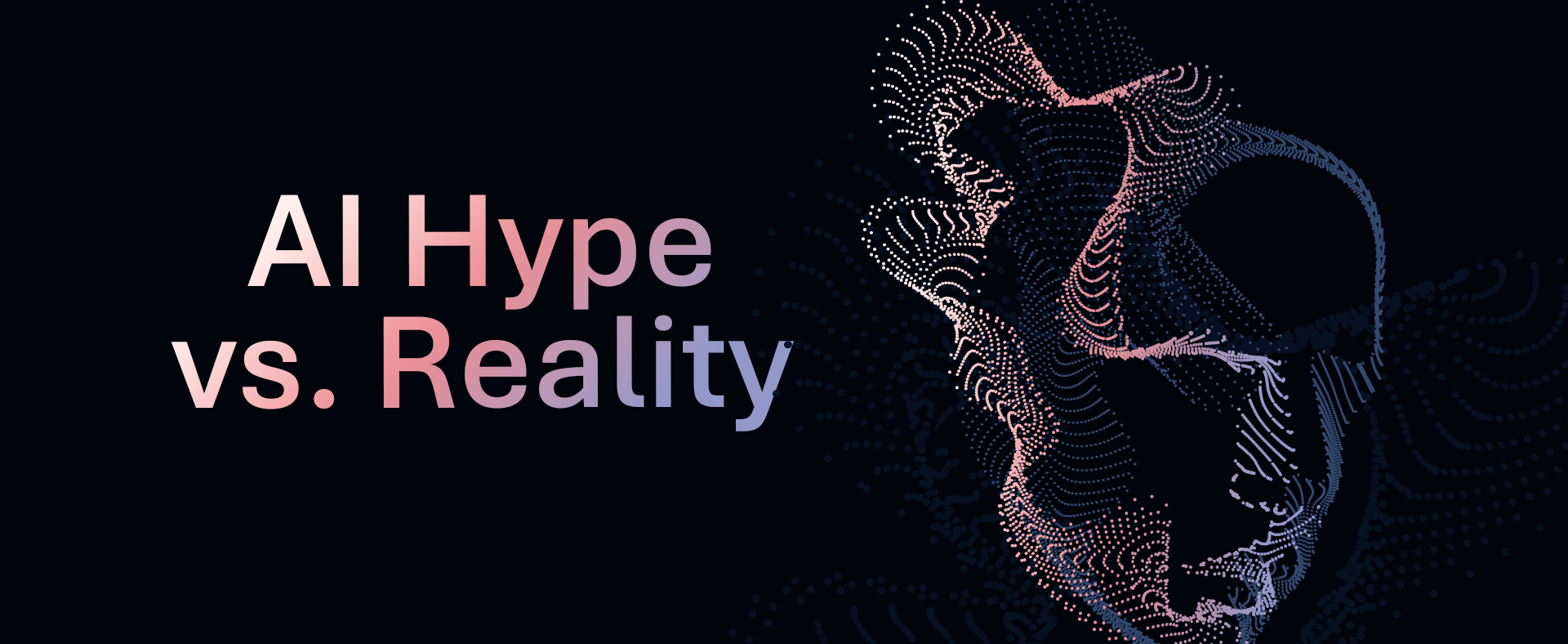Behind the Tech: Stories Shaping Our Digital Future
AI Hype VS Reality Myth Busted

Written by: Exquitech Group
Artificial Intelligence (AI) is at the center of business transformation, promising increased efficiency, cost savings, and innovation. Yet, the hype around AI often creates fear and uncertainty—will it replace jobs? Will it lead to unethical decisions? Can businesses trust AI-driven processes?
The reality is that AI adoption doesn’t have to mean losing control. When implemented responsibly, AI can be a powerful tool that enhances—not replaces—human expertise. In this article, we’ll break down the hype vs. reality of AI, explore the risks and challenges, and provide a framework for responsible and secure AI adoption.
AI Hype vs. AI Reality: Separating Fact from Fiction
AI is often portrayed as an all-powerful, decision-making machine, but the truth is more nuanced. Let’s debunk some of the biggest myths:
🚀 Hype: AI Will Replace Most Human Jobs
🔍 Reality: AI augments human work rather than replacing it entirely. Studies show that AI adoption leads to job evolution, not elimination—creating demand for AI-skilled employees.
📊 Example: A PwC report found that AI could create as many jobs as it displaces by 2037, shifting roles rather than eliminating them.
🤖 Hype: AI Can Make Perfect, Bias-Free Decisions
🔍 Reality: AI models inherit biases from their training data. Businesses must actively audit and refine AI systems to ensure fair and ethical decision-making.
📊 Example: A 2023 MIT study found that biased training data led to AI-driven hiring tools discriminating against women in tech job applications. Companies using AI for hiring must implement bias detection and correction mechanisms.
💡 Hype: AI Can Run Entirely on Its Own
🔍 Reality: AI is not autonomous—it requires human oversight. Continuous monitoring, fine-tuning, and ethical considerations are necessary to ensure AI’s effectiveness and trustworthiness.
📊 Example: Autonomous driving companies like Tesla still require human intervention because AI is not yet foolproof in unpredictable environments.
The Risks of Uncontrolled AI Adoption
Adopting AI without a responsible framework can lead to security risks, compliance issues, and reputational damage. Here are the key concerns:
1. Data Privacy & Security Risks
AI relies on vast amounts of data, making it a prime target for cyber threats. If not properly secured, AI systems can expose sensitive business and customer data.
📊 Statistic: According to IBM, the average cost of a data breach in AI-driven systems is $4.45 million—higher than traditional IT breaches.
🔍 Solution: Businesses must implement robust AI governance policies, encryption techniques, and access controls to safeguard data.
2. Regulatory & Compliance Challenges
Governments worldwide are introducing AI regulations to ensure ethical usage. Non-compliance can result in hefty fines and legal consequences.
📊 Example: The EU AI Act imposes strict rules on high-risk AI applications. Companies using AI for hiring, credit scoring, or biometric surveillance must comply with transparency and risk assessment mandates.
🔍 Solution: Businesses should establish an AI compliance framework aligned with regulations such as GDPR, CCPA, and upcoming AI laws.
3. Unintended Bias & Ethical Issues
AI systems can reinforce existing biases, leading to unfair outcomes in recruitment, lending, and decision-making.
📊 Example: A leading AI-powered healthcare tool was found to prioritize white patients over Black patients due to biased training data.
🔍 Solution: Implement bias detection tools, diverse training datasets, and human oversight to ensure ethical AI use.
🤖 4. Over-Reliance on AI Without Human Oversight
Blindly trusting AI without human intervention can lead to costly mistakes and reputational damage.
📊 Example: A major e-commerce company faced backlash when its AI-driven pricing algorithm accidentally overcharged thousands of customers—resulting in refunds and PR damage.
🔍 Solution: Businesses should adopt a human-in-the-loop (HITL) approach, ensuring AI decisions are monitored and validated by humans.
How to Adopt AI Responsibly: A Secure AI Readiness Framework
To leverage AI without losing control, businesses need a structured AI adoption roadmap. Here’s a step-by-step framework:
✅ Step 1: Define Business Objectives for AI
Ensure AI adoption is driven by real value, not just hype
✅ Step 2: Implement Strong AI Governance & Security
Ensure AI decision-making processes are transparent and auditable
✅ Step 3: Ensure Regulatory Compliance & Ethical AI Use
Maintain human oversight in AI-driven decision-making
✅ Step 4: Foster AI Literacy & Workforce Upskilling
Invest in AI skills development to future-proof the workforce
✅ Step 5: Start with Low-Risk AI Applications & Scale Gradually
Continuously monitor, refine, and adapt AI models based on real-world outcomes
AI Adoption Without Fear: The Future is Human + AI Collaboration
The real future of AI is not machines replacing humans—it’s machines working alongside humans to create more efficient, secure, and ethical workplaces. Companies that embrace AI responsibly will gain a competitive edge while maintaining control, security, and compliance.
🚀 AI should be a strategic enabler, not an unchecked disruptor. By adopting secure and responsible AI practices, businesses can harness AI’s potential without compromising trust, ethics, or security.
Take the Next Step with Exquitech
At Exquitech, we specialize in responsible AI solutions that drive business efficiency without sacrificing control, security, or compliance. Our experts help businesses navigate AI adoption safely, ensuring ethical AI implementation and regulatory compliance.
📞 Contact us today to explore how AI can empower your business—without the risks.
Innovation in Action:
Register for a Demo Now!




